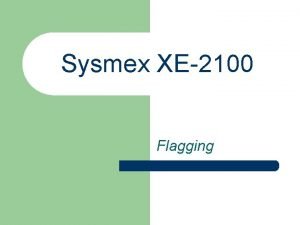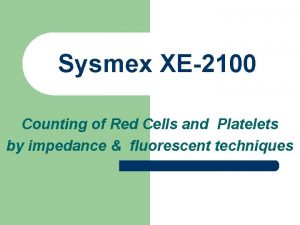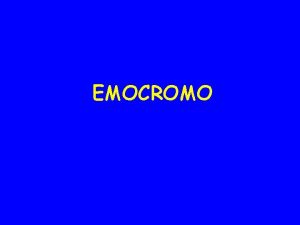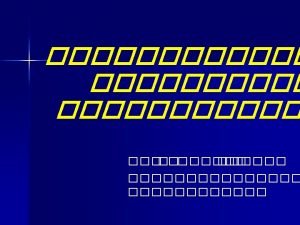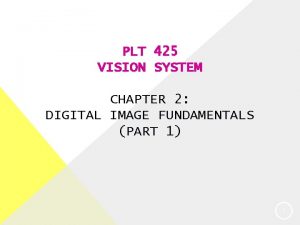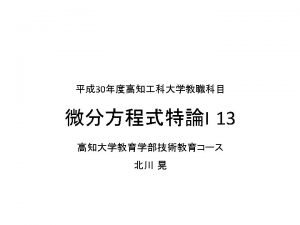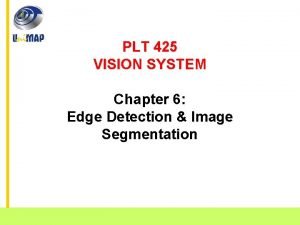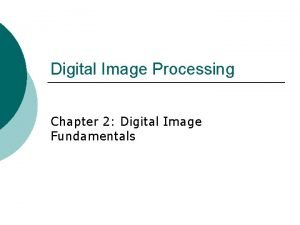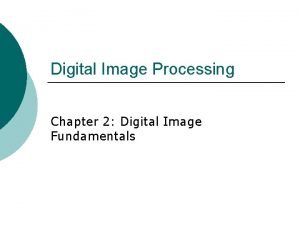PLT 425 VISION SYSTEM CHAPTER 2 DIGITAL IMAGE







![Pixel Array Ø Row and column indices [i, j] are integer values. Ø With Pixel Array Ø Row and column indices [i, j] are integer values. Ø With](https://slidetodoc.com/presentation_image_h2/525299f688b8ec94b74f4f0c4601f825/image-8.jpg)










![Neighbors of a Pixel For a pixel [i, j] in an image : [i-1, Neighbors of a Pixel For a pixel [i, j] in an image : [i-1,](https://slidetodoc.com/presentation_image_h2/525299f688b8ec94b74f4f0c4601f825/image-19.jpg)












- Slides: 31

PLT 425 VISION SYSTEM CHAPTER 2: DIGITAL IMAGE FUNDAMENTALS (PART 2) 1

GENERATING A DIGITAL IMAGE Ø A digital image is a 2 - dimensional array of pixels. Ø Each pixel has an intensity value (represented by a digital number) and a location address (referenced by its row and column numbers). Ø The value of an image at any coordinate (x, y) is denoted as f(x, y) where x and y are integers. 2

GENERATING A DIGITAL IMAGE Pixel Ø Pixel is a smallest component of digital image. Ø A digital image of M rows and N columns of pixels each storing a value. 3

4

Pixels and Values Ø Pixel is a color point of digital image. Ø Pixels values are most often gray levels in the range of 0 -255 (black – white). Grayscale/intensity image 5

6

Binary image RGB image (red-green-blue) 7
![Pixel Array Ø Row and column indices i j are integer values Ø With Pixel Array Ø Row and column indices [i, j] are integer values. Ø With](https://slidetodoc.com/presentation_image_h2/525299f688b8ec94b74f4f0c4601f825/image-8.jpg)
Pixel Array Ø Row and column indices [i, j] are integer values. Ø With regard to spatial resolution, we will map the intensity in our image onto a two-dimensional finite array: n [0, 0] n [1, 0] n [2, 0] n [0, 1] n [0, 2] n [0, 3] n [1, 1] n [1, 2] n [2, 1] n [1, 3] n [2, 2] n [2, 3] Pixel [3, 3] ↓i →j 8

Pixel Array 0 1 2 3 4 5 6 7 8 9 10 11 12 13 14 15 Pixel [i, j] at the 4 th row and 7 th column is yellow Zoom 1600% 9

IMAGE RESOLUTION Ø Image resolution is described in PPI, number of pixels per inch of an image. Ø Resolution (how much you can see the detail of the image) depends on sampling and gray levels. Ø The bigger the sampling rate and the grayscale, the better the approximation of the digitized image from the original. 10

Spatial Resolution Ø The spatial resolution of an image is determined by how sampling was carried out and number of samples used to generate image. Ø Vision specialists will often talk about pixel size. 11

Spatial Resolution - Subsampling Problem? What are some problems that may occur if your images are sampled (or subsampled) to a lower resolution? 12

Checkerboard Effect Ø If the resolution is decreased too much, the checkerboard effect can occur. 13

Intensity Level Resolution Ø Intensity level resolution refers to the number of intensity levels used to represent the image. Ø The more intensity levels used, the finer the level of detail discernible in an image. Ø Intensity level resolution is usually given in terms of the number of bits used to store each intensity level. Ø Most common number of bits used is 8 bits, i. e. Number of gray levels = 28 = 256 levels. 14

Intensity Level Resolution 15

FOREGROUND AND BACKGROUND 16

NEIGHBORS OF A PIXEL 4 -Neighbors of Pixel Ø A pixel p at coordinate (x, y) has four horizontal and vertical neighbors. (x+1, y), (x-1, y), (x, y+1), (x, y-1) (x-1, y) (x, y-1) (x, y) (x+1, y) (x, y+1) Ø Each pixel is a unit distance from (x, y), and some of the neighbor locations of p lie outside the digital image if (x, y) is on the border of the image. 17

8 -Neighbors of Pixel Ø 8 -neighbors of a pixel p are its (x-1, y-1) (x-1, y) (x-1, y+1) (x, y+1) (x+1, y-1) (x+1, y+1) vertical, horizontal and 4 diagonal neighbors (x-1, y-1), (x+1, y-1), (x-1, y), (x+1, y), (x-1, y+1), (x+1, y+1) Ø Each pixel is a unit distance from (x, y), and some of the neighbor locations of p lie outside the digital image if (x, y) is on the border of the image. 18
![Neighbors of a Pixel For a pixel i j in an image i1 Neighbors of a Pixel For a pixel [i, j] in an image : [i-1,](https://slidetodoc.com/presentation_image_h2/525299f688b8ec94b74f4f0c4601f825/image-19.jpg)
Neighbors of a Pixel For a pixel [i, j] in an image : [i-1, j] [i, j-1] [i, j] [i-1, j-1] [i-1, j+1] [i, j-1] [i, j+1] [i+1, j-1] [i+1, j+1] 4 -neighbors (4 -neighborhood) 8 -neighbors (8 -neighborhood) 19

Neighbors of a Pixel • N 4 - 4 -neighbors • ND - diagonal neighbors • N 8 - 8 -neighbors (N 4 U ND) 20

ADJACENCY Ø Two pixels are connected if they are neighbors and their gray levels satisfy some specified criterion of similarity. Ø A pixel p is adjacent to pixel q if they are connected. Ø Example: In a binary image, two pixels are connected if they are 4 -neighbors and have same values (0/1). 21

CONNECTIVITY Ø To determine whether the pixels are adjacent in some sense. Ø Group the same region by assumption that the pixels being the same color or equal intensity will are the same region. Ø Let C is the set of colors used to define. Ø Types of connectivity: - 4 -Connectivity : 2 pixels (p and q) with value in C are 4 -connectivity if q is in the set N 4(p) - 8 -Connectivity : 2 pixels (p and q) with value in C are 8 -connectivity if q is in the set N 8(p) 22

Example: 4 -Connectivity Set of color consists of color 1 ; C ={1} 0 1 1 0 1 0 0 1 1 23

Example: 8 -Connectivity Set of color consists of color 1 ; C ={1} 0 1 1 0 1 0 0 1 1 24

PATH & CONNECTED COMPONENTS Ø Path: A sequence of distinct pixels that are adjacent to each. Ø Connected component: Is a set of pixels that are adjacent to each other. 25

Pop Quiz #1 Determine the neighborhood of the pixel A to F. Allocated time: 5 minutes. 26

DISTANCE MEASURES Ø Distance measurements are commonly used in image processing applications. Ø Distance may show a pixel is close to other pixel. Ø Among the famous and enormously used are: - Euclidean distance - City-block distance (also known as Manhattan distance) - Chessboard distance 27

Distance Function 28

29

Exercise: Distance Measures Calculate the distance from pixel p (1, 2) to pixel q (13, 26) using: a) Euclidean distance b) City-block distance c) Chessboard distance 30

Task Done Using Neighborhood Processing Ø Smoothing / averaging Ø Noise removal / filtering Ø Edge detection Ø Contrast enhancement 31
 Image transform in digital image processing
Image transform in digital image processing Linear position invariant degradation
Linear position invariant degradation Fundamentals of image compression
Fundamentals of image compression Image segmentation in digital image processing
Image segmentation in digital image processing Analog image and digital image
Analog image and digital image Lossless image compression matlab source code
Lossless image compression matlab source code Image sharpening in digital image processing
Image sharpening in digital image processing Image geometry in digital image processing
Image geometry in digital image processing Steps in digital image processing
Steps in digital image processing Digital image processing
Digital image processing Imtransform matlab
Imtransform matlab Image restoration in digital image processing
Image restoration in digital image processing Wbc abn scattergram
Wbc abn scattergram Plt-o sysmex
Plt-o sysmex Plt 404
Plt 404 Istogramma rbc
Istogramma rbc Plt scheme
Plt scheme Plt fuzzy set
Plt fuzzy set Plt electronics
Plt electronics Plt 106
Plt 106 Extra high voltage
Extra high voltage Fcps my plt
Fcps my plt Plt in cbc
Plt in cbc Uts plt
Uts plt คืออะไร
คืออะไร Plt morphology
Plt morphology Import numpy as np import matplotlib.pyplot as plt
Import numpy as np import matplotlib.pyplot as plt Anu gdlp
Anu gdlp Plt
Plt How to draw an ye
How to draw an ye Billy b and plt
Billy b and plt Plt skills
Plt skills












